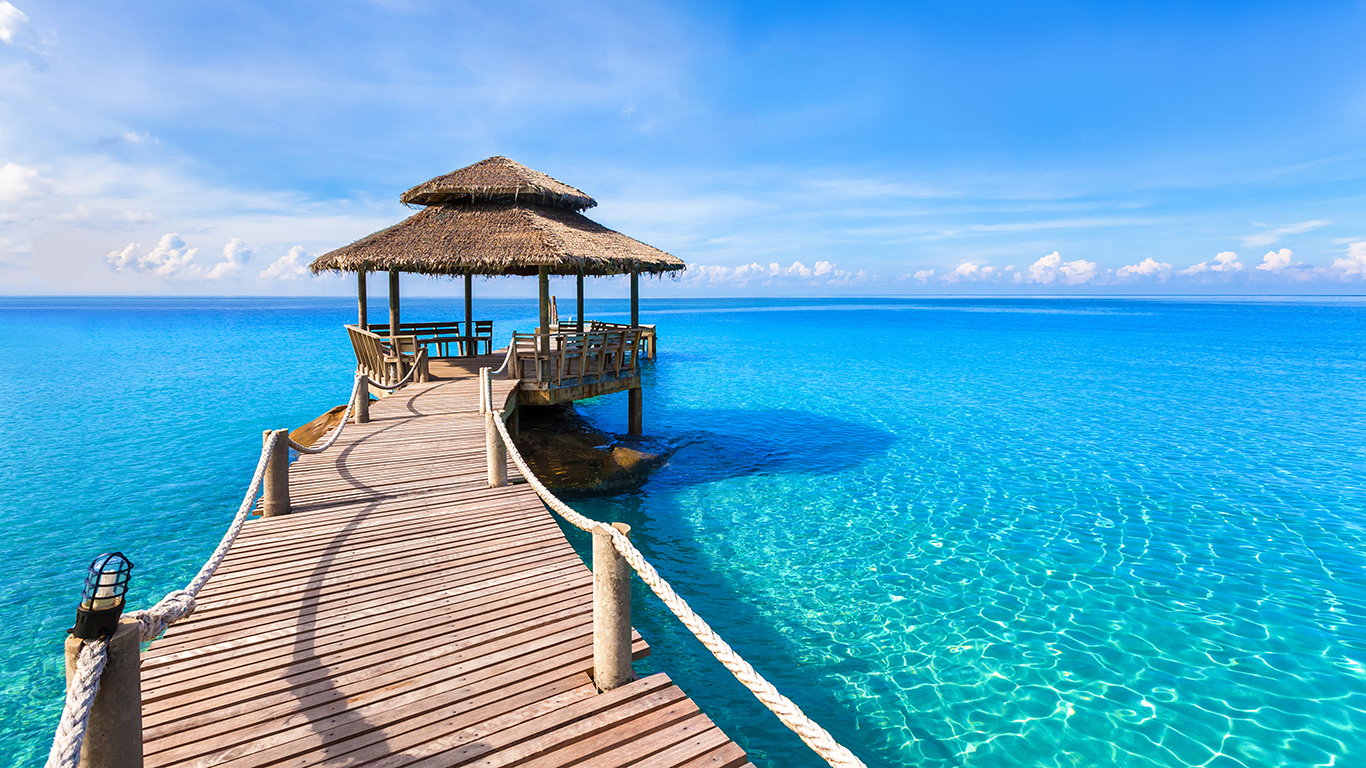
Most people don’t like it when their favorite vacation spot suddenly “gets discovered” and overnight turns into just another crowded beach. Perhaps even more distressing is when that spot is actually in their own hometown.
Many countries face an influx of millions of tourists, often over a short period like winter holiday or spring break, and while their economies may depend on it, local residents and the environment can suffer from the inundation. Some places are already sick and tired of tourists.
The economies of many countries rely heavily on tourism. Governments work to attract more off-season visitors and many residents depend on tourists for their income. Many people nowadays prefer cultural experiences over material things and choose to travel, often to small and offbeat places that may not have been very popular.
24/7 Tempo reviewed a United Nations data to determine the destinations where international tourists are more than local residents. The majority of the 23 vacation places on our list are islands — five of them Caribbean — and are popular places for beach vacations. Others possess the appeal of ancient history, natural wonders, nightlife, or gambling.
To compile the destinations where tourists outnumber locals, 24/7 Tempo used the 2018 Tourism Highlights report from the World Tourism Organization that included international tourist arrival data. The tourist to resident ratio is higher than one in 41 countries, but only countries where it’s higher than two were selected. Arrival numbers are limited to overnight visitors and exclude individuals making day-trips to a destination. Arrivals are defined as a single entry into a country, not a single person. For instance, if someone visited a country twice, both of their visits are counted as arrivals. Numbers are from 2017 and reflect total tourist visits for the year, which means that at any one point there may not have been more tourists than locals in a country, but there were over the course of the year.
Click here to read about destinations where tourists outnumber locals.

23. Portugal
> International tourists: 2.06 per resident
> International tourist arrivals: 21.2 million
> Population 10.3 million
With its temperate weather (Lisbon is the sunniest capital in Europe), and reasonable prices (it’s been named the second most affordable European travel destination after Bulgaria), Portugal is a popular place to vacation. Tourists can drink world class wines, hike on volcanic islands, swim at miles of beaches, and explore medieval cities and castles, all within a country the size of Maine. Some popular attractions are the Livraria Lello bookstore in Porto, which inspired JK Rowling’s Hogwarts library, and the Capela dos Ossos in Evora, a 16th-century chapel decorated with human bones.
[in-text-ad]
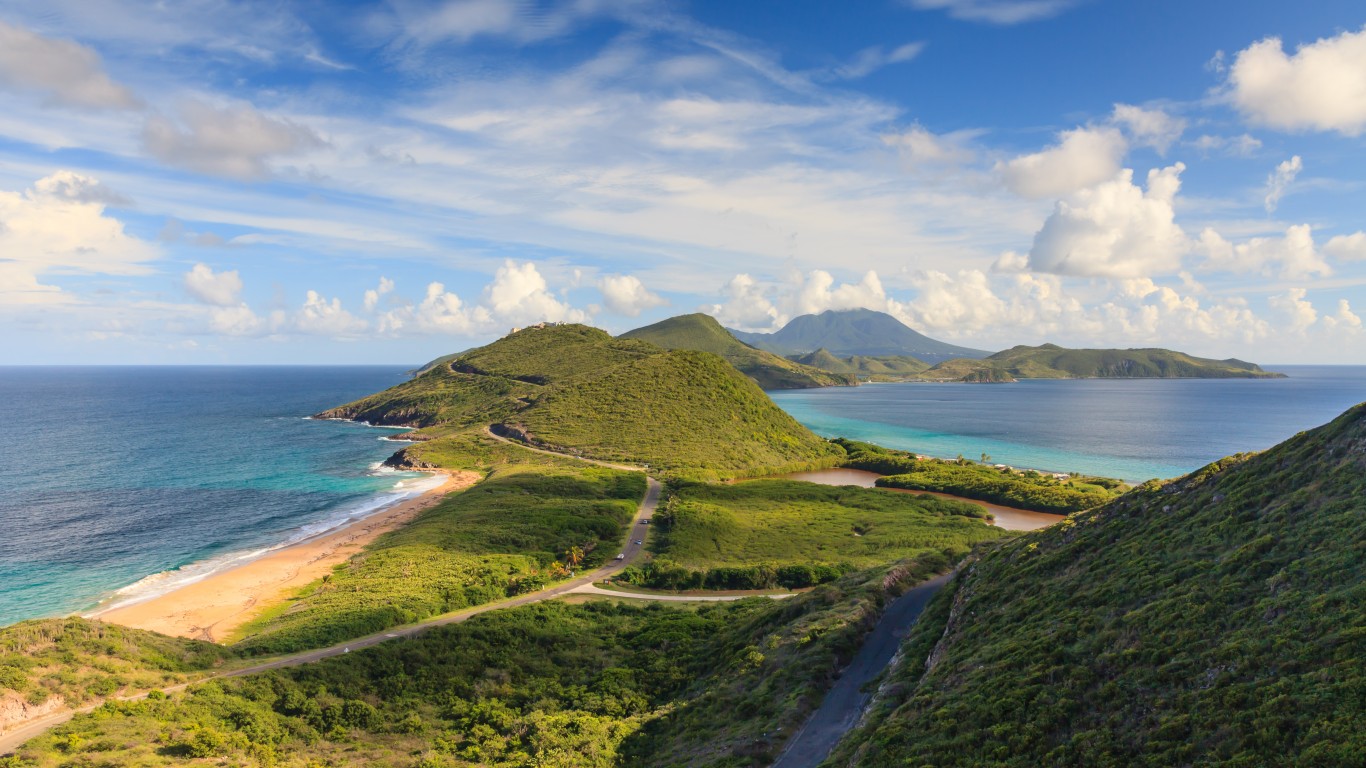
22. St. Kitts and Nevis
> International tourists: 2.07 per resident
> International tourist arrivals: 114,000
> Population 55,000
St. Kitts and Nevis is an island nation of the Lesser Antilles in the Caribbean. The economy, formerly dependent on sugarcane, now relies heavily on tourism. St. Kitts is the larger, livelier island of the pair, with more restaurants, resorts, and nightlife, while Nevis features a pristine natural setting and glaring absence of streetlights, movie theatres, or fast food restaurants. The islands feature a large military fortress called Brimstone Hill that is now a national park, hiking trails through cloud rainforests, multiple iconic beaches and scuba diving areas, and a crater lake inside Mount Liamuiga, a dormant volcano on St. Kitts.

21. Ireland
> International tourists: 2.15 per resident
> International tourist arrivals: 10.4 million
> Population 4.8 million
Between 1845 and 1860, over half the population of Ireland emigrated to avoid starvation. Now, with 70 million people all over the world claiming Irish ancestry, the Emerald Isle is seeing a rise in genealogy tourism. The Irish government has encouraged this, publishing guides to help tourists research their ancestry. For those who travel to Ireland simply to take in the scenery, there are castles, pubs, and seaside cliffs to explore. Over 40% of visitors who come for the first time are from the neighboring Great Britain.

20. Saint Lucia
> International tourists: 2.19 per resident
> International tourist arrivals: 386,000
> Population 176,000
Another popular Caribbean destination, St. Lucia boasts pristine golden sand beaches, a photogenic pair of steep mountains on the southwest shore (the Pitons), a coral reef, rainforest (77% of the island is forested), and a famous “drive-in volcano.” If the natural beauty isn’t enough, there’s also a chocolate plantation, a jazz and arts festival, and dozens of beach-side resorts and hotels nestled into the cliffs and hills along the coast.
[in-text-ad-2]

19. Barbados
> International tourists: 2.32 per resident
> International tourist arrivals: 664,000
> Population 286,000
A British colony until 1966, Barbados is full of English relics and architecture — from the churches to statues to St. Ann’s Fort, an 18th-century military base. Residents even drive on the left side of the road. Aside from the natural beauty — warm water beaches, coral reefs, and botanical gardens — the island is famous for its rum, West Indian cuisine, nightlife, and shopping. It is also the birthplace of pop singer and icon Rihanna, who has been a cultural ambassador of the island since 2008.
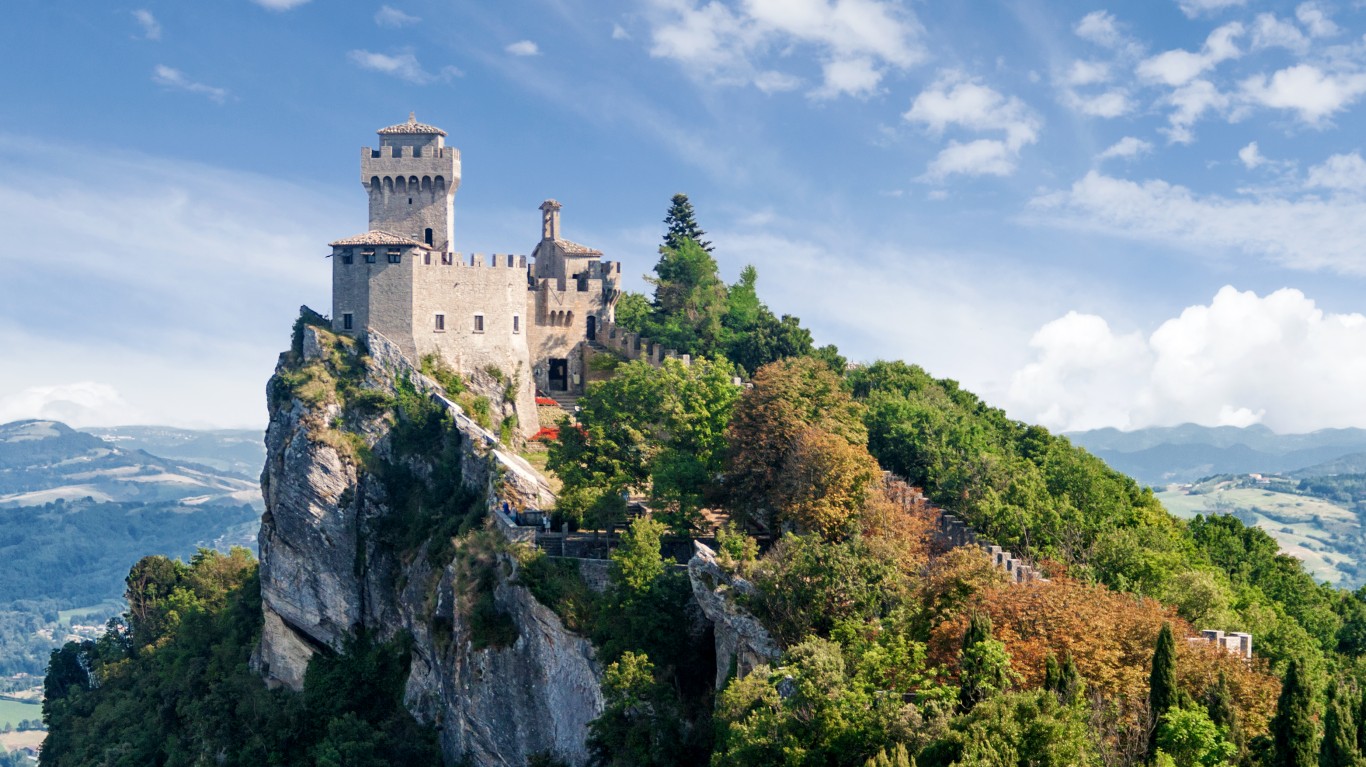
18. San Marino
> International tourists: 2.36 per resident
> International tourist arrivals: 78,000
> Population 33,000
San marino, a small country landlocked inside Italy, is the world’s oldest sovereign state and the fifth smallest country in the world, at just 23.5 square miles. Situated on the top of a mountain with sweeping panoramic views of the Italian countryside, San Marino offers tourists duty-free shopping, an 11th-century fortress, and many examples of traditional architecture. Though exploring the streets on foot can be tiring considering the mini-country is built on a mountain, visitors can take a cable car ride back up to the top.
[in-text-ad]
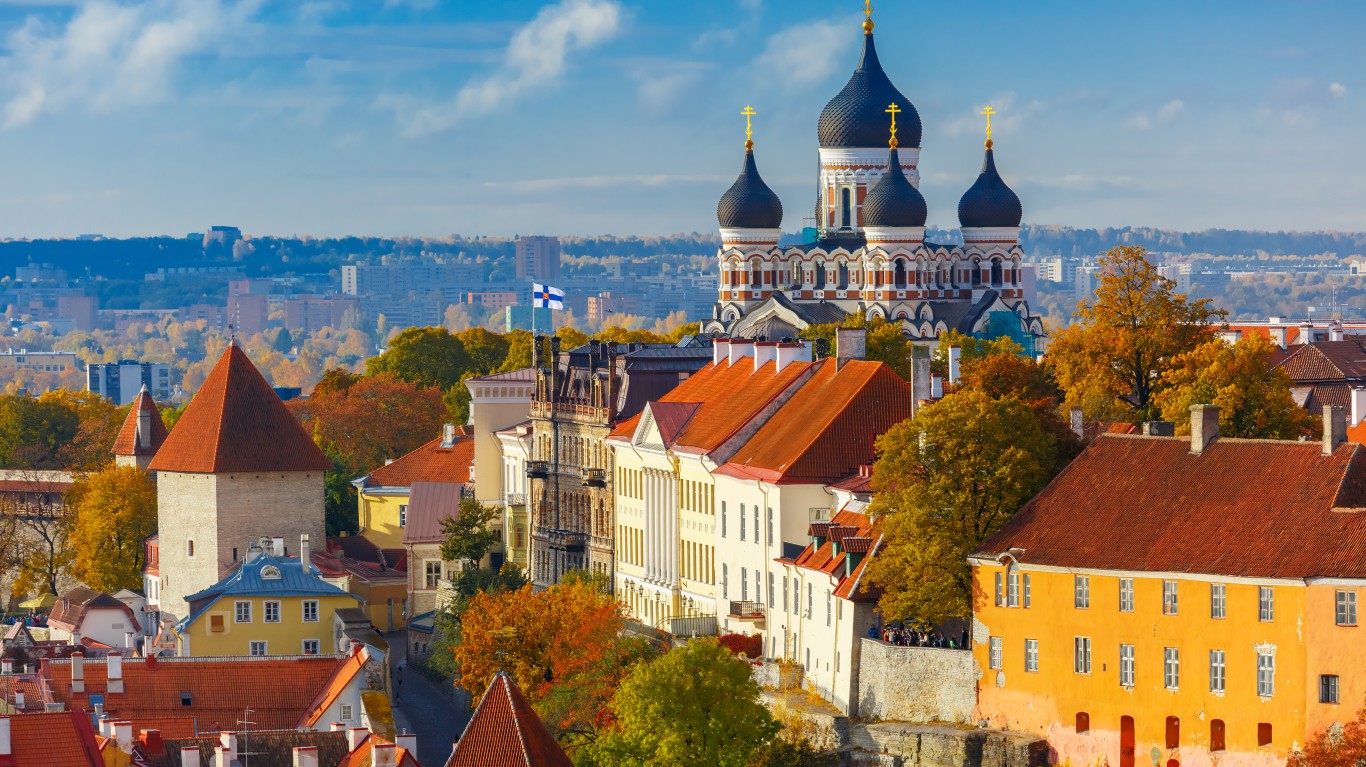
17. Estonia
> International tourists: 2.46 per resident
> International tourist arrivals: 3.2 million
> Population 1.3 million
Touted as a country that remains relatively unknown to tourists, Estonia is becoming a popular destination for folks who dislike the crowds common in other European vacation spots. The capital city of Tallinn features a historic cobble-stoned Town Hall Square, 13th-century architecture, and multiple churches and cathedrals to visit. Prices are low compared to the rest of Europe, and restaurants are known to carry high quality, local, seasonal ingredients. A unique activity popular among visitors is bog walking in the country’s many peat bogs.

16. Singapore
> International tourists: 2.48 per resident
> International tourist arrivals: 13.9 million
> Population 5.6 million
A popular destination for both corporate and leisure travelers, Singapore is known for its cultural diversity (the country has four official languages), extreme cleanliness, and exquisite cuisine. In 2016, it became the first Southeast-Asian country to receive its own Michelin Guide. Among the tourist attractions are the longest elevated infinity pool in the world, and hundreds of cheap food courts called hawker centres, and two famous casino resorts, Marina Bay Sands and Resorts World Sentosa. Singapore’s visitor arrivals grew by 20% after the opening of the casinos in 2010.
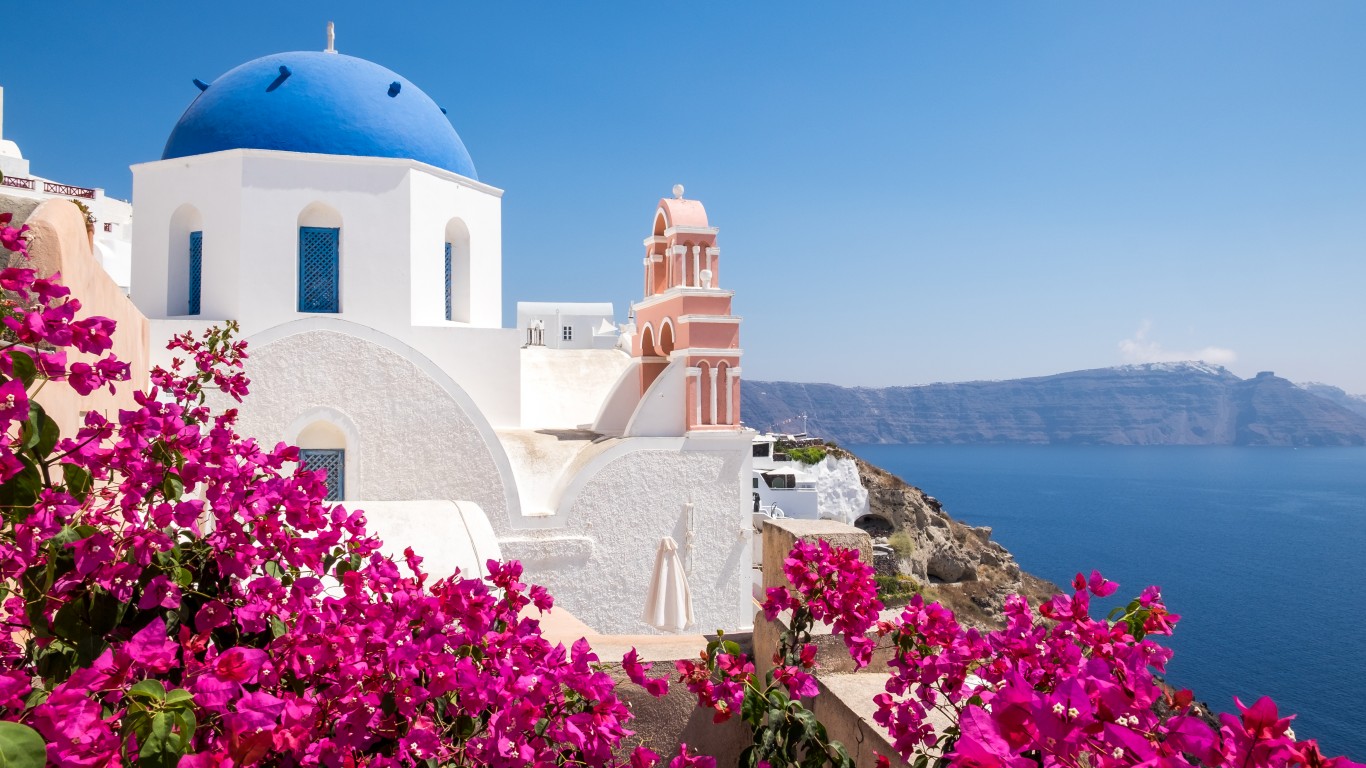
15. Greece
> International tourists: 2.53 per resident
> International tourist arrivals: 27.2 million
> Population 10.8 million
Greece, a country packed with history and architecture, has seen the most growth in tourism of any European country in the last decade. In fact, though nearly a quarter of Greek workers are in the tourism sector and the success of the industry has been indispensable in keeping the country’s economy afloat, many Greek towns are being strained by overtourism. Small towns, sick and tired of tourists, and islands can’t keep up with the influx of millions of visitors during a brief period. In 2017, to curb tourist impact, the mayor of Santorini island limited cruise ship disembarkation to 8,000 people a day.
[in-text-ad-2]

14. Antigua and Barbuda
> International tourists: 2.71 per resident
> International tourist arrivals: 247,000
> Population 91,000
The former sugarcane islands of Antigua and Barbuda are famous for their hundreds of beaches. For those who prefer adventure to lying in the sand, many companies provide opportunities for parasailing, windsurfing, snorkeling, and scuba diving. Tourists can also take Land-Rover tours around smaller towns and into the rainforests. Antigua, a common day-trip stop for cruise ships, is also a restaurant hot-spot, with local cuisine featuring sweet potato or cornmeal and okra dumplings, fish, conch, goat, and small Antiguan black pineapples.

13. Montenegro
> International tourists: 3.01 per resident
> International tourist arrivals: 1.9 million
> Population 624,000
With beaches on the Adriatic Sea, medieval towns, and snow-capped mountains, Montenegro is a small country with a lot to offer visitors. It’s cheaper than Croatia but on the same coastline with similar Mediterranean-style cuisine, quaint waterfront towns full of churches and markets, yachting, and architecture dating back to the 12th century. Some of the natural wonders of the country are Durmitor National Park, a glacial formation of gorges, mountains, and lakes-and the Tara River Canyon, one of Europe’s deepest canyons.
[in-text-ad]
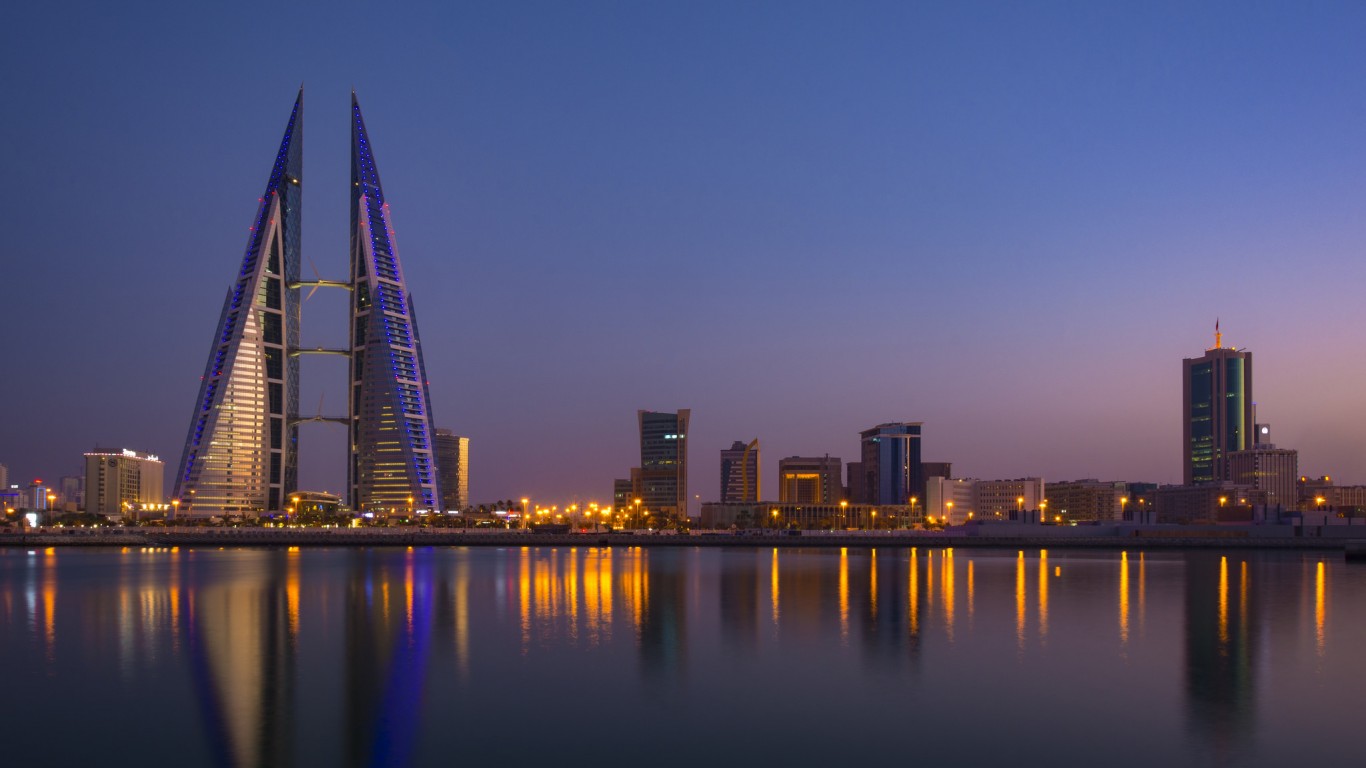
12. Bahrain
> International tourists: 3.01 per resident
> International tourist arrivals: 4.4 million
> Population 1.5 million
An island nation in the Persian Gulf, Bahrain is known for its liberal culture, and is a popular weekend and holiday destination for people from more conservative Muslim countries. Here they can do things forbidden by their governments, like dance, watch foreign films, go to concerts, and drink alcohol. Tourists from nearby Arab countries, specifically Saudi Arabia, make up most of the visitor arrivals. According to Khaled bin Humood Al-Khalifa, the CEO of Bahrain Tourism and Exhibitions Authority, 83% of visitors enter the country via a causeway connecting it to Saudi Arabia, whereas only 17% arrive by air.

11. Austria
> International tourists: 3.34 per resident
> International tourist arrivals: 29.5 million
> Population 8.8 million
In 2017, the World Economic Forum’s Travel and Competitiveness report rated Austria number one in tourist service infrastructure, and Mercer named Vienna, Austria’s capital, the city with the best quality of life for the eighth year in a row, partially due to Vienna’s museums, theaters, and opera. With nearly 30 million visitors a year, Austria is known for its arts and music culture, low crime rate, Alpine skiing, rich confectionery, and historic architecture. Small villages, such as the mountain lake town Hallstatt, are popular destinations.
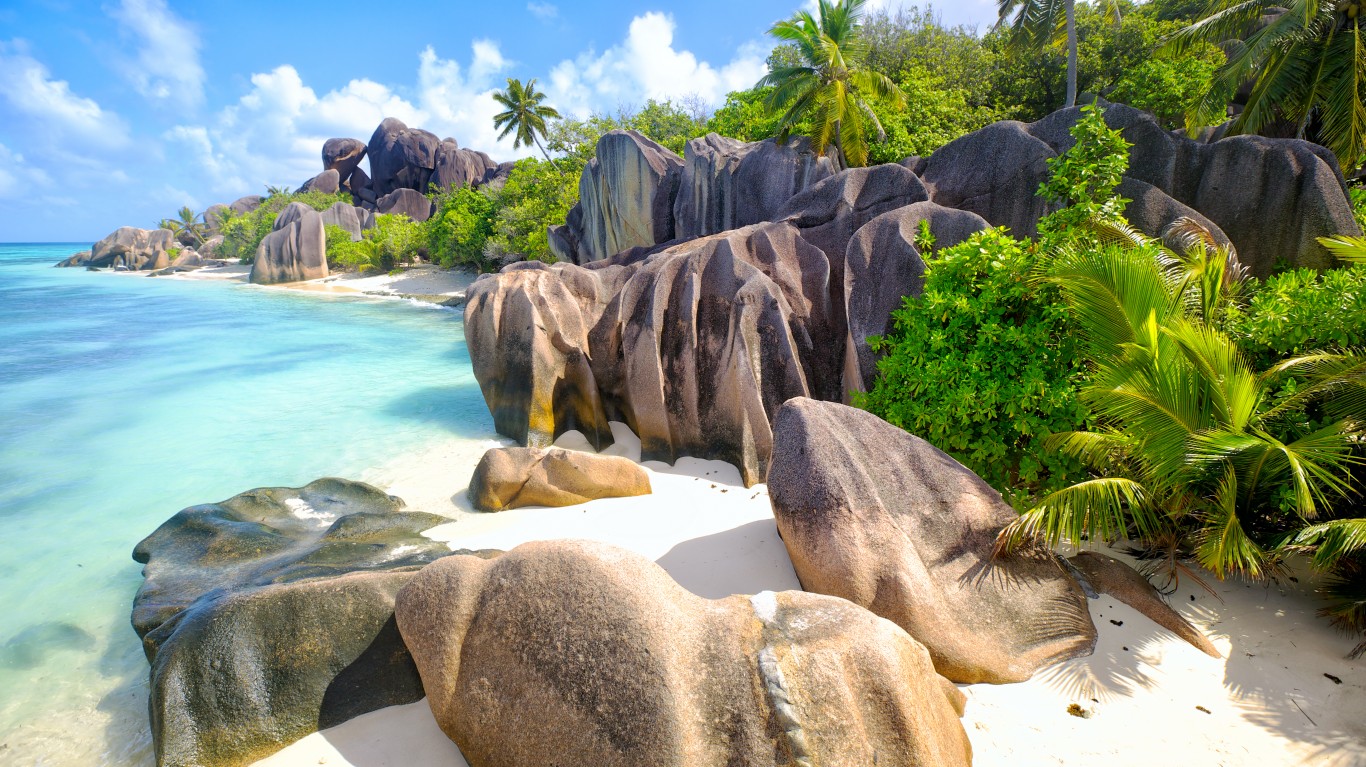
10. Seychelles
> International tourists: 3.72 per resident
> International tourist arrivals: 350,000
> Population 94,000
The Seychelles, 900 miles off the African coast, are a remote destination comprised of 115 islands, many of which are uninhabited. Victoria, the capital city, is the only one in the country with a population over 5,000. Tourism began with the opening of the country’s first airport in 1971. There are currently over 500 hotels, resorts, and other tourist accommodations on the islands, which are known for their unique flora and fauna, and beautiful beaches. Anse Source D’Argent on La Digue Island is said to be one of the most photographed beaches in the world.
[in-text-ad-2]

9. Hong Kong SAR
> International tourists: 3.76 per resident
> International tourist arrivals: 27.9 million
> Population 7.4 million
A growing number of tourists in Hong Kong are coming from mainland China — 75% in 2018, after the 2003 introduction of an “individual visit scheme,” which opened the doors for mainlanders from certain Chinese cities to enter Hong Kong without needing to be a part of a business or tour group. Amidst mounting hostility from locals, who sometimes end up unable to buy basic necessities due to the influx of visitors, the government has not opened the scheme to more cities since 2007, and is instead focusing on attracting overseas tourists. A vibrant metropolis, Hong Kong offers an epic city skyline, affordableMichelin starred restaurants, endless shopping, boat rides, street art, and amusement parks.

8. Croatia
> International tourists: 3.78 per resident
> International tourist arrivals: 15.6 million
> Population 4.1 million
Game of Thrones fans may know that the fortress in Old Town Dubrovnik, Croatia, is the filming location of King’s Landing, but the ancient city is also a UNESCO World Heritage Site, and one of the most popular tourist attractions. Brimming with historic cities, ancient architecture, spectacular local fare, eight national parks, and over 400 beaches, Croatia is a popular vacation destination. The country’s mainland and islands have over 3,600 miles of coastline, only 15% of which is urbanized, with some of the best beaches solely accessible by boat.
[in-text-ad]

7. Maldives
> International tourists: 3.86 per resident
> International tourist arrivals: 1.4 million
> Population 360,000
Off the southwest coast of Sri Lanka are the Maldives, a chain of islands and ring-shaped atolls (coral reef formations that often enclose lagoons). The first three resorts in the Maldives opened in 1972, and tourism has been growing there ever since. The country has planned its tourist infrastructure around the concept of “one island, one resort.” There are now over 100 resorts, with only one per island, maintaining a private and relaxing experience for visitors. Besides swimming with whale sharks, witnessing bioluminescent phytoplankton (a “sea of stars” at night), and visiting the elaborate Grand Friday Mosque, tourists also have the option of arriving by seaplane and staying in a stilted water bungalow.
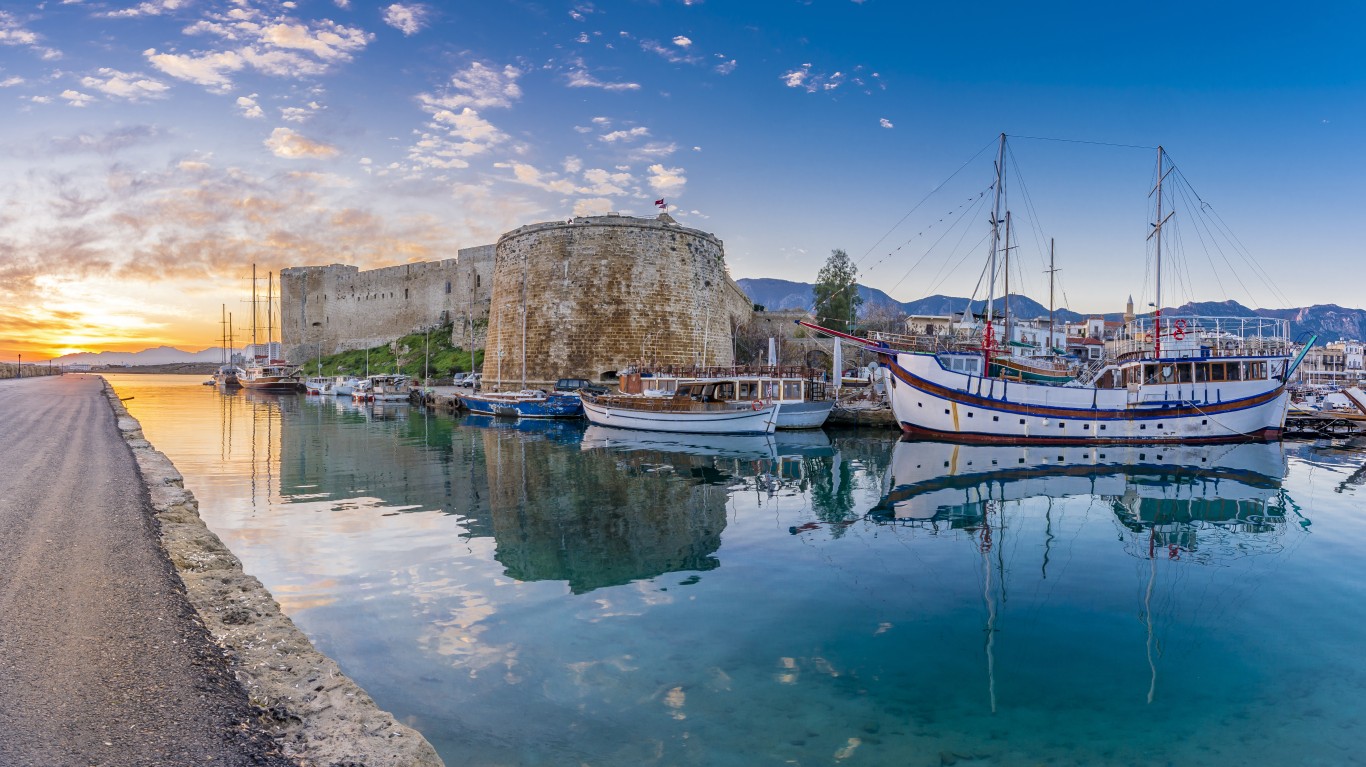
6. Cyprus
> International tourists: 4.27 per resident
> International tourist arrivals: 3.7 million
> Population 855,000
The island of Cyprus has a rich history, having been settled for over 10,000 years. Located in the Mediterranean Sea, close to Greece, Turkey, and Lebanon, its culture and cuisine are a blend of European, Asian, and Middle Eastern. It’s a popular spot for European vacationers, with over a million tourists from the U.K. alone, as English is widely spoken. It’s reputed to have some of the cleanest beach water in Europe, and is also known for its friendly locals and ancient architecture.

5. Malta
> International tourists: 4.94 per resident
> International tourist arrivals: 2.3 million
> Population 460,000
Another Mediterranean hot spot, Malta lies just off the southern coast of Italy. Though Maltese is the country’s main language, most residents also speak English, as the country is a former British colony. This makes it a popular destination for tourists from the U.K., Malta’s largest tourist source. A few highlights to be found are the blue lagoon of Comino Island, the ancient walled city of Mdina, and the famous Caravaggio painting, Beheading of St John the Baptist at St John’s Co-Cathedral.
[in-text-ad-2]

4. Iceland
> International tourists: 6.58 per resident
> International tourist arrivals: 2.2 million
> Population 338,000
Tourism in Iceland was nearly nonexistent in the 20th century, but after a financial crash in 2008, the country became known as a cheap place to visit, where tourists could gaze at the northern lights while bathing in a hot spring. A common layover stop for travelers headed to other European destinations from North America, Iceland capitalized on its location with a campaign offering cheaper airfare to travelers who’d make a pitstop in the country for up to a week. The eruption of an Icelandic volcano in 2010, rather than threatening the country’s image as a safe place to travel, put Iceland on the map, and the tourism industry responded with a successful marketing campaign highlighting the country’s natural beauty.
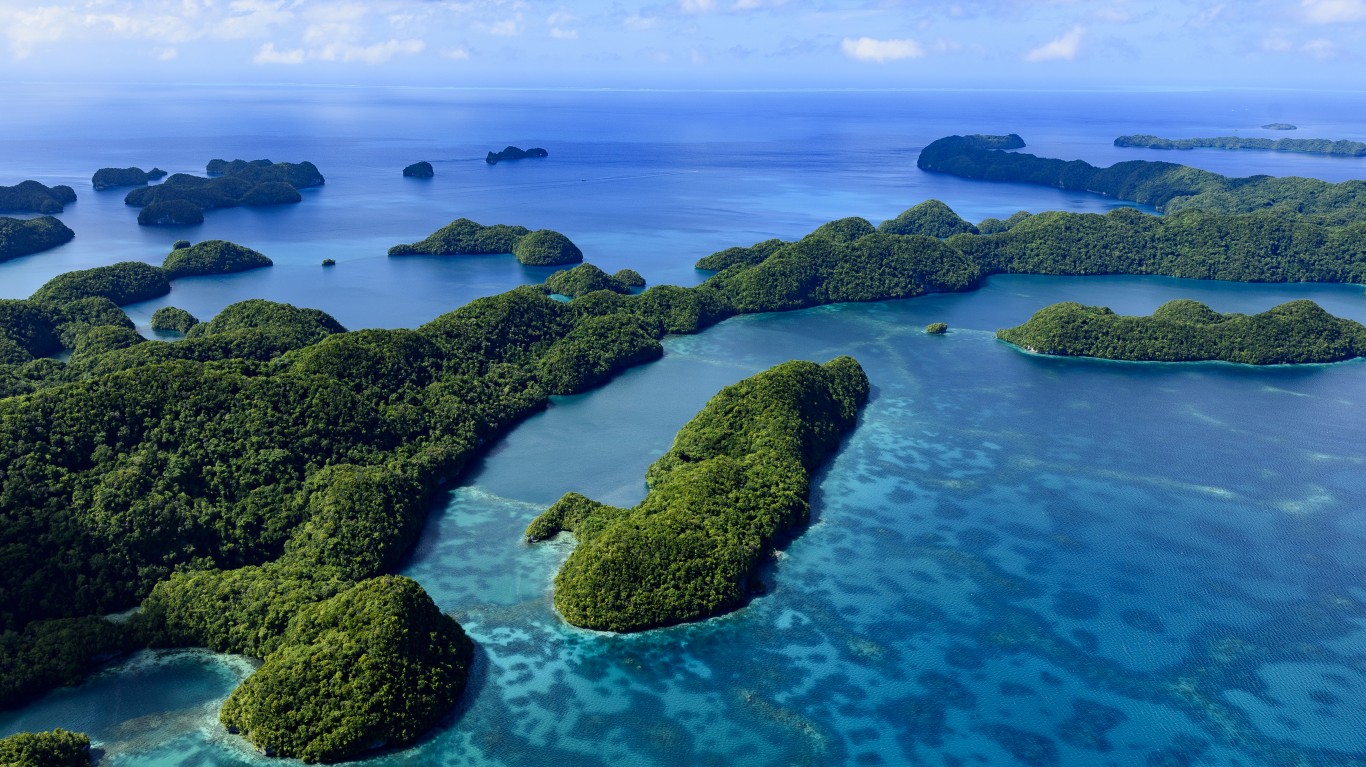
3. Palau
> International tourists: 6.83 per resident
> International tourist arrivals: 123,000
> Population 18,000
As tourism in the remote island nation of Palau grows yearly, reaching almost seven times the local population in 2017, damage to the country’s delicate ecosystems is mounting. In December of 2017, the country instituted a mandatory pledge for visitors, in which they must agree to be environmentally conscious and tread lightly during their trip. The pledge will help protect Palau’s barrier reef and coral atolls, Rock Islands (a series of limestone peaks), Jellyfish Lake (containing over five million of a species of jellyfish only found in this location), and Clear Lake (a 12,000- to 15,000-year-old saline lake).
[in-text-ad]
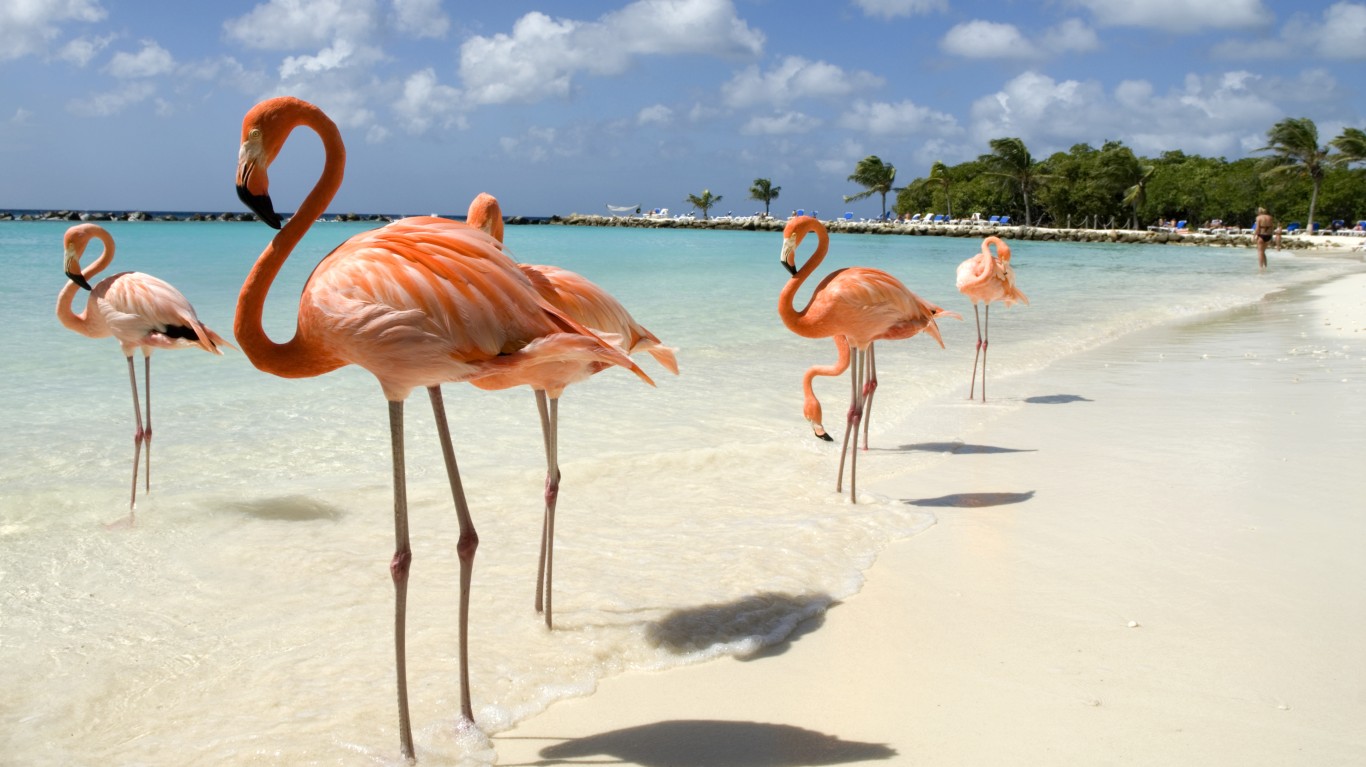
2. Aruba
> International tourists: 9.65 per resident
> International tourist arrivals: 1.1 million
> Population 111,000
Out of the five Caribbean countries on our list, Aruba has the most tourists per resident. This may be due to a multitude of factors. It’s known to be one of the safer Caribbean islands in terms of crime and also hurricane danger. The water is some of the cleanest in the world, and each year residents and tourists participate in a beach clean-up day. American tourists — as well as visitors from about 90 other countries — don’t need a visa to enter, and all the major resorts have their own casinos. Perhaps best of all for travelers from the United States is that most businesses take U.S. dollars.

1. Macau SAR
> International tourists: 26.42 per resident
> International tourist arrivals: 17.3 million
> Population 653,000
Macau, a Special Administrative Region of China, was under Portuguese rule for over 400 years until 1999, when it returned to Chinese authority. Since then, it has become the largest gambling city in the world by revenue, with over 30 casinos, and is the sole gambling destination for Chinese citizens, as it’s the one legal place to gamble in China. Over 70% of visitors come from China, and the casinos are tailored to Chinese customers, many featuring baccarat, Asians’ game of choice.
Get Ready To Retire (Sponsored)
Start by taking a quick retirement quiz from SmartAsset that will match you with up to 3 financial advisors that serve your area and beyond in 5 minutes, or less.
Each advisor has been vetted by SmartAsset and is held to a fiduciary standard to act in your best interests.
Here’s how it works:
1. Answer SmartAsset advisor match quiz
2. Review your pre-screened matches at your leisure. Check out the advisors’ profiles.
3. Speak with advisors at no cost to you. Have an introductory call on the phone or introduction in person and choose whom to work with in the future
Thank you for reading! Have some feedback for us?
Contact the 24/7 Wall St. editorial team.
 24/7 Wall St.
24/7 Wall St.



